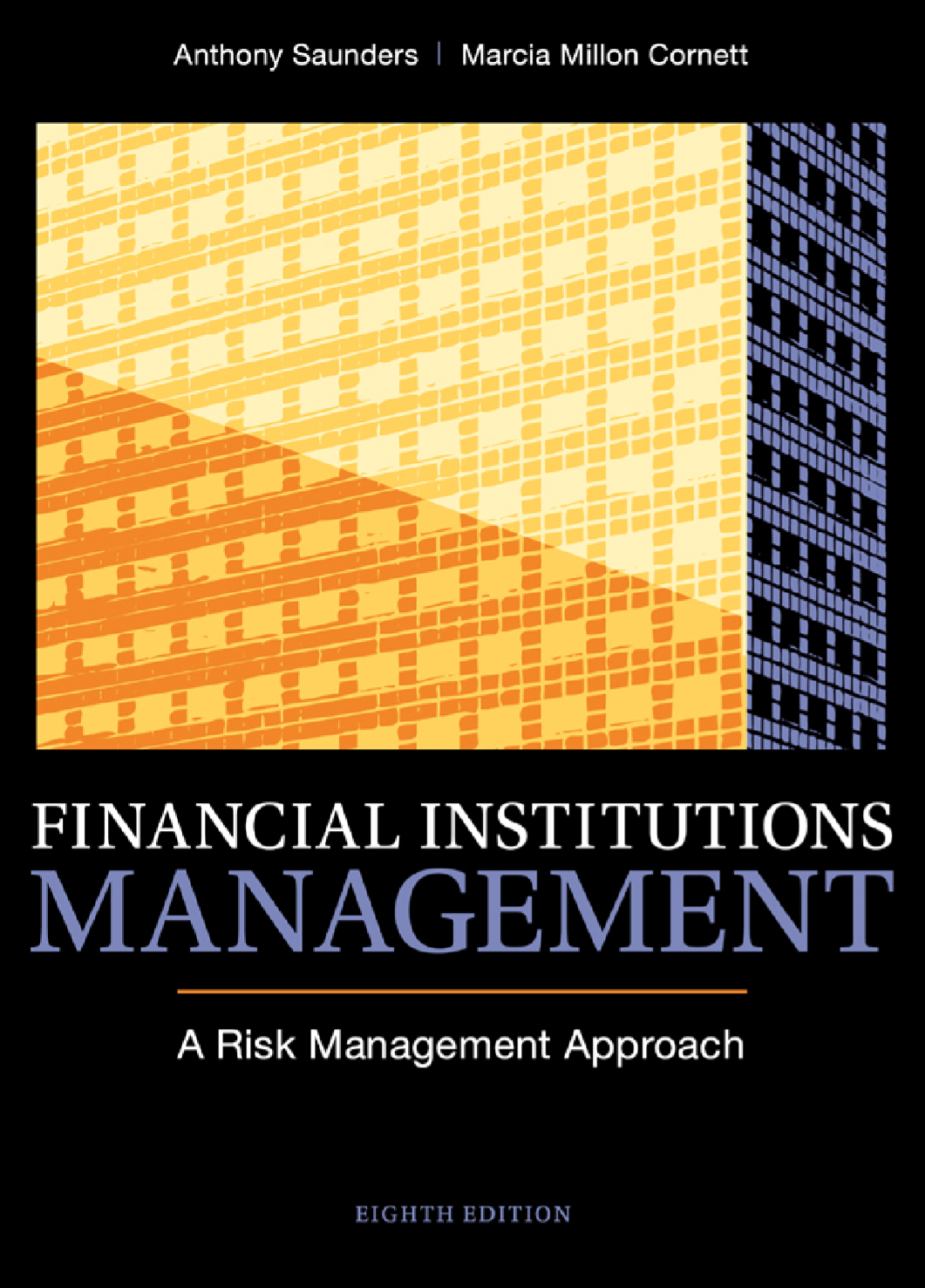Financial Institutions Management A Risk Management 8th
Financial Institutions Management A Risk Management 8th

Anthony Saunders
Anthony Saunders is the John M. Schiff Professor of Finance and the former Chair of the Department of Finance at the Stern School of Business at New York University. Professor Saunders received his PhD from the London School of Economics and has taught both undergraduate- and graduate-level courses at NYU since 1978. Throughout his academic career, his teaching and research have specialized in financial institutions and international banking. He has served as a visiting professor all over the world, including INSEAD, the Stockholm School of Economics, and the University of Melbourne. P rofessor Saunders has held positions on the Board of Academic Consultants of the Federal Reserve Board of Governors as well as the Council of Research Advisors for the Federal National Mortgage Association. In addition, Dr. Saunders has acted as a visiting scholar at the Comptroller of the Currency and at the Federal Reserve Banks of Philadelphia and New York. Currently, he is an academic consultant for the FDIC. He also held a visiting position in the research department of the International Monetary Fund. He is editor of Financial Markets, Instruments and Institutions. His research has been published in all the major money and banking and finance journals and in several books. In addition, he has authored or coauthored several professional books, the most recent of which is Credit Risk Measurement: New Approaches to Value at Risk and Other Paradigms, 3rd edition, John Wiley and Sons, New York, 2010. In 2008, he was ranked as the most published author in the last 50 years in the top seven journals in finance.
Marcia Millon Cornett
Marcia Millon Cornett is a Professor of Finance at Bentley University. She received her BS degree in Economics from Knox College in Galesburg, Illinois, and her MBA and PhD degrees in Finance from Indiana University in Bloomington, Indiana. Dr. Cornett has written and published several articles in the areas of bank performance, bank regulation, and corporate finance. Articles authored by Dr. Cornett have appeared in such academic journals as the Journal of Finance, the Journal of Money, Credit and Banking, the Journal of Financial Economics, Financial Management, and the Journal of Banking and Finance. In 2008, she was ranked as the 124th most published author in the last 50 years in the top seven journals in finance. Dr. Cornett served as an Associate Editor of Financial Management and is currently an Associate Editor for the Journal of Banking and Finance, Journal of Financial Services Research, FMA Online, the Multinational Finance Journal, and the Review of Financial Economics. She has served as a member of the Board of Directors, the Executive Committee, and the Finance Committee of the SIU Credit Union. Dr. Cornett has also taught at the University of Colorado, Boston College, Southern Methodist University, and Southern Illinois University at Carbondale. She is a member of the Financial Management Association, the American Finance Association, and the Western Finance Association.
Preface
he last 25 years have been dramatic for the financial services industry. In the 1990s and 2000s boundaries between the traditional industry sectors, such as commercial banking and investment banking, broke down, and competition became increasingly global in nature. Many forces contributed to this breakdown in interindustry and intercountry barriers, including financial innovation, technology, taxation, and regulation. Then in 2008–09, the financial services industry experienced the worst financial crisis since the Great Depression. Even into the mid-2010s, the U.S. and world economies have not recovered from this crisis. It is in this context that this book is written. Although the traditional nature of each sector’s product activity is analyzed, a greater emphasis is placed on new areas of activities such as asset securitization, off-balance-sheet banking, international banking, and on changes occurring as a result of the financial crisis. When the first edition of this text was released in 1994, it was the first to analyze modern financial institutions management from a risk perspective. Thus, the title,
Financial Institutions Management: A Modern Perspective. At that time, traditional texts presented an overview of the industry sector by sector, concentrating on balance sheet presentations and overlooking management decision making and risk management. Over the last 20 years other texts have followed this change, such that a risk management approach to analyzing modern financial institutions is now well accepted. Thus, the title: Financial Institutions Management: A Risk Management Approach. The eighth edition of this text takes the same innovative approach taken in the first seven editions and focuses on managing return and risk in modern financial institutions (FIs). Financial Institutions Management ’s central theme is that the risks faced by FI managers and the methods and markets through which these risks are managed are similar whether an institution is chartered as a commercial bank, a savings bank, an investment bank, or an insurance company. A s in any stockholder-owned corporation, the goal of FI managers should always be to maximize the value of the financial institution. However, pursuit of value maximization does not mean that risk management can be ignored. I ndeed, modern FIs are in the risk management business. As we discuss in this book, in a world of perfect and frictionless capital markets, FIs would not exist and individuals would manage their own financial assets and portfolios. But since real-world financial markets are not perfect, FIs provide the positive function of bearing and managing risk on behalf of their customers through the pooling of risks and the sale of their services as risk specialists.
Excellent Due 论文代写网提醒你,代写如迷宫弯弯,如何玩玩,可有万万,路径叫人换?这刹人生幻幻,丝丝环环,怎敢缓缓,煮酒难言欢?至觉旅途漫漫,轻褛蔓蔓,可否慢慢,秉烛在夜谈?知觉命运坎坎,命数堪堪,仍笑侃侃,在多赏一晚。不要总是想太多,路还长,命还久,多去选择,毕竟人生在世只是在不断选择正确的选择罢了。

